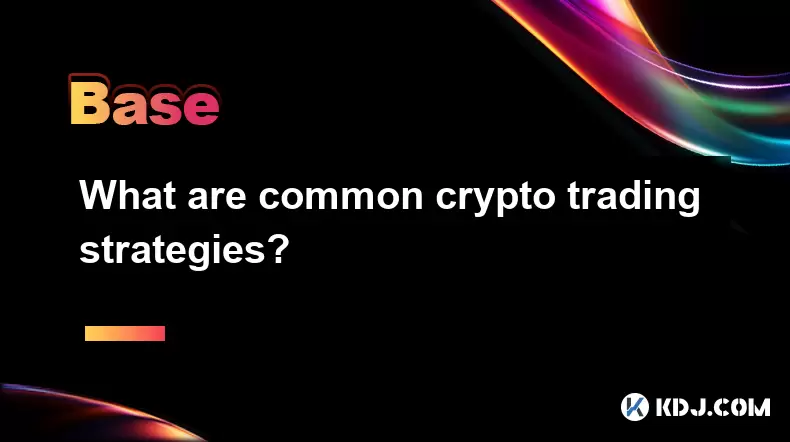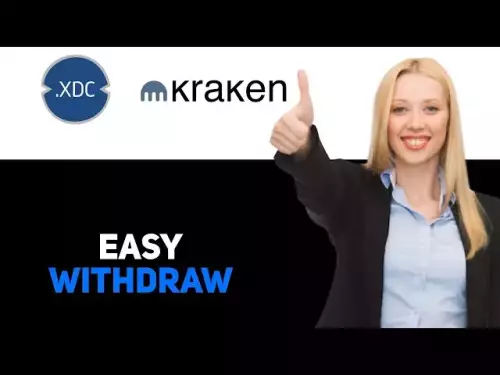-
 bitcoin
bitcoin $114684.631706 USD
-0.87% -
 ethereum
ethereum $4228.677447 USD
1.58% -
 bnb
bnb $1294.880693 USD
-1.16% -
 tether
tether $1.000819 USD
-0.02% -
 xrp
xrp $2.605138 USD
2.79% -
 solana
solana $209.908690 USD
5.89% -
 usd-coin
usd-coin $0.999903 USD
-0.03% -
 dogecoin
dogecoin $0.213423 USD
2.93% -
 tron
tron $0.322721 USD
-0.10% -
 cardano
cardano $0.727247 USD
3.66% -
 hyperliquid
hyperliquid $42.339456 USD
6.05% -
 chainlink
chainlink $19.910811 USD
5.16% -
 ethena-usde
ethena-usde $1.000557 USD
0.00% -
 stellar
stellar $0.349734 USD
2.69% -
 bitcoin-cash
bitcoin-cash $543.848687 USD
-0.21%
What are common crypto trading strategies?
Trend following in crypto leverages momentum, using tools like moving averages and MACD to ride bullish or bearish trends while managing risk with stop-losses.
Aug 08, 2025 at 12:42 pm

Understanding Trend Following in Crypto Trading
Trend following is one of the most widely adopted crypto trading strategies due to its simplicity and alignment with market momentum. Traders using this method aim to identify and ride existing market trends, whether upward (bullish) or downward (bearish). The core idea is that price movements tend to continue in the same direction over time, especially in volatile markets like cryptocurrencies.
To apply this strategy effectively, traders rely on technical indicators such as the Moving Average (MA) and Moving Average Convergence Divergence (MACD). For instance:
- Use the 50-day and 200-day moving averages to detect long-term trends.
- When the short-term MA crosses above the long-term MA, it signals a bullish trend.
- Conversely, a cross below indicates a bearish trend.
- The MACD histogram helps confirm the strength of the trend by measuring momentum.
Traders often combine these tools with support and resistance levels to refine entry and exit points. For example, entering a long position when the price breaks above a key resistance level during an uptrend increases the probability of success. It’s crucial to set stop-loss orders below recent swing lows in uptrends or above swing highs in downtrends to manage risk.
Leveraging Range Trading Techniques
Range trading is ideal in sideways or consolidating markets, where prices move between predictable high and low boundaries. This strategy works best when there is no clear directional trend, which is common in crypto markets during periods of low volatility or indecision.
The foundation of range trading lies in identifying support and resistance zones. These are price levels where the asset has historically reversed direction. Once established:
- Buy near the support level where demand is strong.
- Sell or short near the resistance level where supply tends to dominate.
- Use Bollinger Bands to visualize volatility and confirm range boundaries.
- Apply the Relative Strength Index (RSI) to detect overbought (above 70) or oversold (below 30) conditions within the range.
For example, if Bitcoin has been fluctuating between $30,000 and $35,000 for several weeks, a range trader would place buy orders near $30,000 and sell orders near $35,000. Automating this with limit orders on exchanges like Binance or Kraken ensures execution without constant monitoring. However, traders must remain alert for breakouts, which can invalidate the range and trigger false signals.
Mastering Breakout Trading Approaches
Breakout trading focuses on capitalizing on price movements that exceed established support or resistance levels. This strategy is particularly effective after periods of consolidation, where pent-up buying or selling pressure leads to sharp price moves.
To execute a breakout strategy:
- Identify a tight consolidation pattern, such as a triangle, rectangle, or flag formation.
- Monitor trading volume—a genuine breakout is usually accompanied by a significant volume spike.
- Enter the trade when the price closes decisively beyond the resistance (for upside breakouts) or support (for downside breakouts).
- Use volume-weighted average price (VWAP) to assess whether the breakout has institutional backing.
For instance, if Ethereum has been trading between $1,800 and $1,900 for ten days and suddenly surges past $1,900 on high volume, a breakout trader would enter a long position. To avoid false breakouts (also known as 'fakeouts'), some traders wait for a retest of the broken level, which now acts as new support. Placing a stop-loss just below this retest level minimizes risk.
Applying Scalping for Short-Term Gains
Scalping involves making dozens or even hundreds of trades per day to capture small price changes. This strategy suits traders who can dedicate significant time to monitoring charts and executing rapid decisions, often using leverage to amplify returns.
Key components of successful scalping include:
- Choosing high-liquidity pairs like BTC/USDT or ETH/USDT to ensure fast order execution.
- Using 1-minute or 5-minute candlestick charts for precise timing.
- Employing order book depth and time & sales data to anticipate short-term price shifts.
- Relying on exponential moving averages (EMA) and stochastic oscillators for quick signal generation.
A typical scalping setup might involve:
- Watching for price to touch the lower Bollinger Band while the Stochastic is in oversold territory.
- Entering a long position with a tight stop-loss just below the recent low.
- Setting a profit target at the middle Bollinger Band or upper band.
- Closing the trade within minutes once the target is reached.
Due to the high frequency of trades, transaction fees can erode profits. Therefore, scalpers often use exchanges with maker fee rebates or low-cost fee structures. Risk management is critical—never risk more than 1% of capital on a single scalping trade.
Utilizing Arbitrage Opportunities Across Exchanges
Arbitrage exploits price differences of the same cryptocurrency across different exchanges. For example, Bitcoin might trade at $30,000 on Exchange A and $30,150 on Exchange B. This $150 gap presents a risk-free profit opportunity if executed correctly.
To perform cross-exchange arbitrage:
- Monitor real-time price feeds using tools like CryptoWatch or custom scripts.
- Ensure both exchanges support fast deposits and withdrawals.
- Calculate net profit after fees and withdrawal times—some gaps disappear before funds are transferred.
- Execute the buy order on the cheaper exchange and simultaneously place a sell order on the higher-priced one.
Challenges include withdrawal delays, network congestion, and exchange-specific restrictions. Some traders use stablecoins to reduce transfer times, while others focus on triangular arbitrage within a single exchange—trading between three pairs (e.g., BTC/USDT, ETH/BTC, ETH/USDT) to exploit mispricing.
Automated bots are commonly used to detect and act on arbitrage opportunities within milliseconds, as manual execution is often too slow.
Frequently Asked Questions
What is the minimum capital required to start trend following?There is no fixed minimum, but having at least $500–$1,000 allows for better position sizing and risk management. Smaller accounts may struggle with fee impact and limited diversification.
How do I avoid false breakouts in range trading?Wait for confirmed closes beyond the level and check for volume confirmation. A breakout on low volume is suspect. Also, use a buffer zone—for example, only act if the price moves 1–2% past the resistance.
Can scalping be automated effectively?Yes, many traders use algorithmic bots written in Python or available on platforms like 3Commas. These bots can monitor multiple pairs, place orders, and manage risk based on predefined rules.
Is arbitrage still profitable in today’s crypto market?Profitability has decreased due to increased competition and faster markets, but niche opportunities still exist—especially with newly listed tokens or regional exchange discrepancies. Speed and low latency are essential.
Disclaimer:info@kdj.com
The information provided is not trading advice. kdj.com does not assume any responsibility for any investments made based on the information provided in this article. Cryptocurrencies are highly volatile and it is highly recommended that you invest with caution after thorough research!
If you believe that the content used on this website infringes your copyright, please contact us immediately (info@kdj.com) and we will delete it promptly.
- XRP Price Prediction: Weekend Rollercoaster or Rally?
- 2025-10-12 08:45:16
- Bittensor (TAO): Super Bullish Signals Point to Potential 2x Rally
- 2025-10-11 10:25:12
- Silver Price Correction: Navigating the Dip & Identifying Key SEO Keywords
- 2025-10-11 10:25:12
- Decoding Crypto Trends: Bittensor's Bull Run, Cardano's Dip, and LivLive's Presale Buzz in 'Uptober 2025'
- 2025-10-12 08:45:16
- MoonBull: The Crypto Meme Coin Promising 1000x Gains?
- 2025-10-11 10:30:01
- Crypto Payroll Revolution: Stablecoins, Altcoins, and the Future of Salary Payments
- 2025-10-11 10:30:01
Related knowledge

How do decentralized identity (DID) solutions work?
Oct 14,2025 at 11:36pm
Understanding Decentralized Identity in the Blockchain Ecosystem1. Decentralized identity (DID) solutions are built on blockchain networks, allowing i...

What does it mean for code to be "open source" in crypto?
Oct 12,2025 at 01:54pm
Understanding Open Source in the Cryptocurrency Ecosystem1. In the context of cryptocurrency, open source refers to software whose code is publicly ac...

What is the purpose of a "testnet"?
Oct 12,2025 at 09:01am
Understanding the Role of Testnets in Blockchain Development1. A testnet serves as a parallel version of a blockchain network, designed specifically f...

How to avoid phishing scams in crypto?
Oct 13,2025 at 06:18pm
Understanding Common Crypto Phishing Tactics1. Cybercriminals frequently use fake websites that mirror legitimate crypto exchanges or wallet platforms...

What is the difference between single-collateral and multi-collateral Dai?
Oct 12,2025 at 05:18pm
Understanding Single-Collateral Dai1. Single-Collateral Dai (SCD) was the original version of the Dai stablecoin launched by MakerDAO in 2017. It allo...

What is a "sidechain"?
Oct 13,2025 at 02:36pm
Understanding the Concept of Sidechains1. A sidechain is a blockchain that operates independently but is connected to another blockchain, known as the...

How do decentralized identity (DID) solutions work?
Oct 14,2025 at 11:36pm
Understanding Decentralized Identity in the Blockchain Ecosystem1. Decentralized identity (DID) solutions are built on blockchain networks, allowing i...

What does it mean for code to be "open source" in crypto?
Oct 12,2025 at 01:54pm
Understanding Open Source in the Cryptocurrency Ecosystem1. In the context of cryptocurrency, open source refers to software whose code is publicly ac...

What is the purpose of a "testnet"?
Oct 12,2025 at 09:01am
Understanding the Role of Testnets in Blockchain Development1. A testnet serves as a parallel version of a blockchain network, designed specifically f...

How to avoid phishing scams in crypto?
Oct 13,2025 at 06:18pm
Understanding Common Crypto Phishing Tactics1. Cybercriminals frequently use fake websites that mirror legitimate crypto exchanges or wallet platforms...

What is the difference between single-collateral and multi-collateral Dai?
Oct 12,2025 at 05:18pm
Understanding Single-Collateral Dai1. Single-Collateral Dai (SCD) was the original version of the Dai stablecoin launched by MakerDAO in 2017. It allo...

What is a "sidechain"?
Oct 13,2025 at 02:36pm
Understanding the Concept of Sidechains1. A sidechain is a blockchain that operates independently but is connected to another blockchain, known as the...
See all articles

























![[4K 60fps] Prisma by novichokk (1 Coin) [4K 60fps] Prisma by novichokk (1 Coin)](/uploads/2025/10/14/cryptocurrencies-news/videos/k-fps-prisma-novichokk-coin/68ee49804ba00_image_500_375.webp)
















































